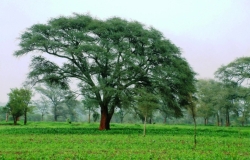2 November 2010
Evergreen agriculture emerges as Africa's key to food security
by Kate Melville
 Crop production occurring under a full canopy of trees sounds counter-intuitive, but a unique acacia known as a "fertilizer tree" is allowing African farmers to triple maize yields. Attendees at The Hague Conference on Agriculture, Food Security and Climate Change were told yesterday that evergreen agriculture - the integration of fertilizer trees into crop and livestock-holding farms - is rapidly emerging as an affordable and accessible solution to improving production on Africa's farms.
Crop production occurring under a full canopy of trees sounds counter-intuitive, but a unique acacia known as a "fertilizer tree" is allowing African farmers to triple maize yields. Attendees at The Hague Conference on Agriculture, Food Security and Climate Change were told yesterday that evergreen agriculture - the integration of fertilizer trees into crop and livestock-holding farms - is rapidly emerging as an affordable and accessible solution to improving production on Africa's farms.
"Doubling food production by mid-century, particularly in Africa, will require nonconventional approaches, particularly since so many of the continent's soils are depleted, and farmers are faced with a changing climate," said Dr. Dennis Garrity, Director General of the World Agroforestry Centre. "We need to reinvent agriculture in a sustainable and affordable way, so that it can reduce its emissions of greenhouse gases and be adapted to climate change."
In a recent article in Food Security, Garrity explained how evergreen agriculture has already provided benefits to several million farmers in Zambia, Malawi, Niger and Burkina Faso. Fertilizer trees draw nitrogen from the air and transfer it to the soil through their roots and leaf litter, replenishing exhausted soils with rich sources of organic nutrients. The trees bolster nutrient supply, increase food crop yields, and enhance the production of fodder, fuel and timber. These systems also provide additional income to farmers from tree products, while at the same time storing much greater amounts of carbon than other agricultural systems.
Garrity notes how farmers in Malawi have increased their maize yields by up to 280 percent when the crop is grown under a canopy of one particular fertilizing tree, Faidherbia albida. Unlike most other trees, Faidherbia sheds its leaves during the early rainy season and remains dormant during the crop-growing period. This makes it highly compatible with food crops because it does not compete with them for water, nutrients, or light - only the bare branches of the tree's canopy spread overhead while crops of maize, sorghum, or millets grow to maturity below. The leaves and pods also provide a crucial source of fodder in the dry season for livestock when nearly all other plants have dried up. The trees may continue to provide these cost-free benefits for up to 70 to 100 years.
In Niger, there are now more than 4.8 million hectares of millet and sorghum being grown in agroforests that have up to 160 Faidherbia trees on each hectare. And increased crop yields aren't the only benefit. Other studies have suggested that integrating agroforestry into farming systems on a massive scale would create a vital carbon bank. The Intergovernmental Panel on Climate Change estimates that a billion hectares of developing country farmland is suitable for conversion to carbon agroforestry projects.
A broad alliance is now emerging of governments, research institutions, and international and local development partners committed to expanding evergreen agriculture and agroforestry. "We are already working with 18 countries across the African continent to develop national plans for the accelerated implementation of evergreen agriculture," Garrity explained. "Evergreen agriculture allows us to glimpse a future of more environmentally-sound farming where much of our annual food crop production occurs under a full canopy of trees."
Related:
Unique tree could help feed Africa
Source: The Hague Conference on Agriculture, Food Security and Climate Change
